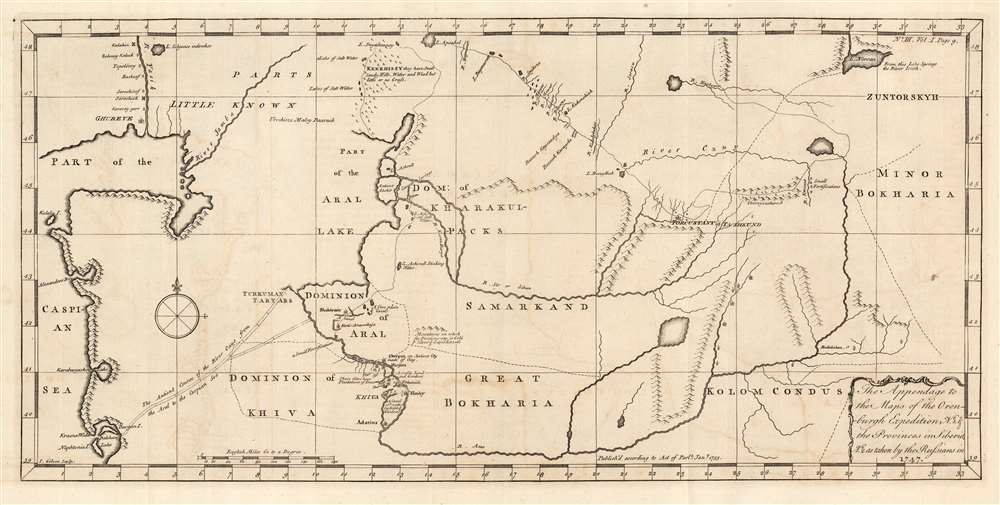1753 Jonas Hanway Map of Independent Tartary
IndependentTartary-gibson-1753
Title
1753 (dated) 9.25 x 19.25 in (23.495 x 48.895 cm) 1 : 4056307
Description
The Orenbergh Expedition
Ivan Kirillovich Kirilov (Иван Курилов, 1689 - 1737), the father of Russian Cartography, took part in Shestakov's expedition to Kamchatka between 1731 and 1733. The experience led him to appreciate the economic and strategic opportunities offered Russia in assessing her more remote provinces. In 1734, he proposed the creation of an administrative center to aid the assessment and exploitation of Russia's southeastern frontier regions. The ambitious project called for the construction of fortresses and even cities in order to extend Russia's influence and the reach of her geographers. To this end, the city of Orenburg was constructed in the southern Urals in 1735, the site having been chosen by Kirilov himself. Specifically, his intent was '...opening up transit routes to Bukhara, Badakhshan, Bulk, and to India'. Kirilov died in 1737, but the bureaucracy he established lived on under new administrators. After several false starts, Orenburg was re-founded in 1743, at the juncture of the Yaik and the Sakmara rivers, its present location. From that time on, Orenburg functioned as both a military and administrative center on the Kazakh frontier. Exploration in the Caspian region fell within Orenberg's sphere of influence. Even the work of English merchant explorers like Woodroofe and Elton would inform the geographical information compiled at Orenberg. This did not guarantee, however, that the material disseminated by the Expedition would be state-of-the-art: the maps based on the Orenberg Expedition that came to Jonas Hanway fell far short of his own maps of the Caspian and the Aral Sea published in the same work.Publication History and Census
The chart was engraved by John Gibson in 1753 for inclusion in Jonas Hanway's An Historical Account of the British Trade over the Caspian Sea. We are aware of three editions of the work; this example appeared in the third. We see eight examples of the complete work in institutional collections. We see only three examples of this map catalogued in OCLC, in the 1753 issue, at the Bibliotheque National de France, the National Library of Scotland, and the National Library of Israel.CartographerS
Jonas Hanway (August 12, 1712 - September 5, 1786), was an English philanthropist, traveller, and writer. He was apprenticed in 1729 to a merchant in Lisbon, but in 1743 he became partner to merchant and member of the British Russia Company Robert Dingley (1710 - 1780) who was based in St. Petersburg. This led to the travels in Russia, Central Asia, and Persia which would inform Hanway's (copious) writing on the topic of British trade in the Caspian Sea, which would earn him the attentions of scholar Charles Wilson who hailed him 'one of the most indefatigable and splendid bores of English history.' On his return to London his narrative brought him some fame and success, and thereafter he remained in the city devoted to good causes and good citizenship. He founded The Marine Society in 1756 (a charity supporting inland youths wishing to go to sea.) He was instrumental in the aid of various hospitals; arranged improvements in Londons's birth registration system; and in 1762 he was appointed a commissioner for victualling the navy. Hanway was an eccentric and a gadfly. He protested, voluminously, the English practice of tea drinking, both on the grounds of its effect on the health and on the balance of foreign trade. He was the first male Londoner to carry an umbrella. This shocking move drew the opprobrium of fellow Londoners who objected to the effeminate, French contraption, and the ire of hansom cab drivers who quite correctly identified the invention as a threat to their trade (rainstorms caused Londoners to flock to hansom cabs as a sheltered means of transport.) He died unmarried. A monument to his memory stands in Westminster Abbey, praising his works of charity. It discusses neither umbrellas nor tea. More by this mapmaker...
John Gibson (1724 – 1773) was an English map engraver active in London at the end of the 18th century. Gibson was the son of a locksmith. In 1739 he apprenticed to John Blundell as a stationer of Grub Street. Gibson proved a fine engraver and was much in demand by London map publishers. During his career he produced thousands of maps and was admired as a skilled engraver and sculptor. Among others, he engraved for Emanuel Bowen, Robert Sayer, Jean Palairet, John Rocque, Andrew Dury, and Benjamin Martin. His best known work was prepared in conjunction with Gentleman's Magazine. Gibson, sadly, was not as astute in his fiscal affairs as with the engravers pen and consequently spent much of his life consigned to debtor's prison. Learn More...

